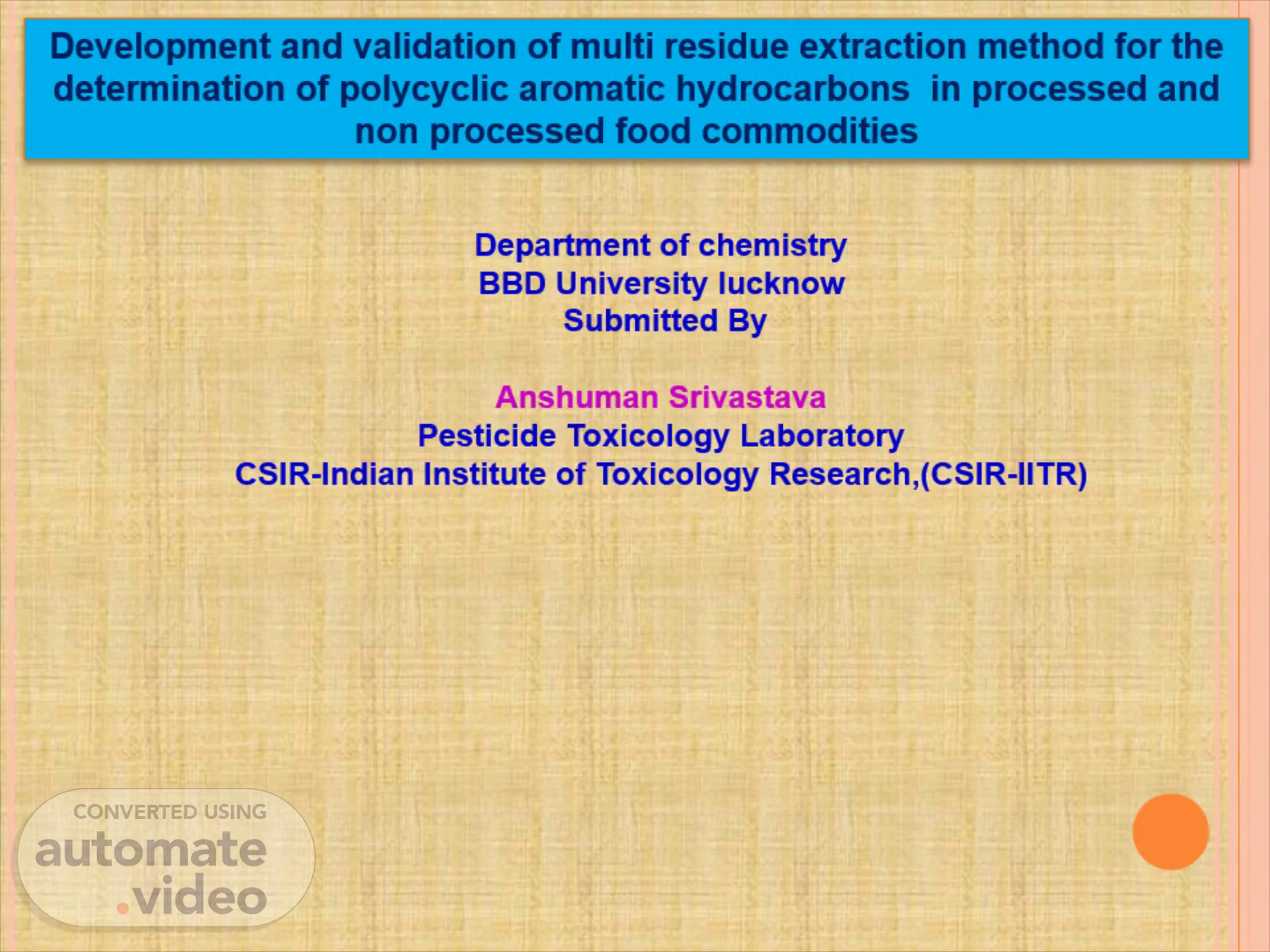Scene 1 (0s)
Department of chemistry BBD University lucknow Submitted By Anshuman Srivastava Pesticide Toxicology Laboratory CSIR-Indian Institute of Toxicology Research,(CSIR-IITR).
Scene 2 (23s)
PAHs refer to a large group of organic chemicals containing two or more fused aromatic rings made up of carbon and hydrogen atoms. PAHs are lipophilic and chemically stable. Over 100 PAHs are present in the environment as pollutants..
Scene 3 (38s)
PAHs are formed during processing of coal, crude oil and natural gas, and incomplete burning of coal, oil, gas, garbage, and other organic substances. They are also present in vehicle emissions and tobacco smoke. Some PAHs are manufactured by industry and are used in the production of PVC, plasticisers, pigments, dyes and pesticides. They are ubiquitous in the environment, being present in air, soil, water and food..
Scene 4 (1m 1s)
Sl. No. Polycyclic Aromatic Hydrocarbons Molecular Formula Molecular Weight 1 Naphthalene C 10 H 8 128 2 Phenanthrene C 14 H 10 178 3 Anthracene C 14 H 10 178 4 Fluoranthene C 16 H 10 202 5 Pyrene C 16 H 10 202 6 Chrysene C 18 H 10 228 7 Benzo[a] athracene C 18 H 12 228 8 Benzo[b] Fluoranthene C 20 H 12 252 9 Acenaphthylene C 20 H 12 252 10 Acenapthene C 20 H 12 252 11 Benzo[a] pyrene C 20 H 12 252 12 Fluorene C 20 H 12 252 13 Benzo[a]anthracene-d12 C 22 H 12 240 14 Dibenzo[ah] Anthracene C 22 H 14 278 15 Benzo [k] fluorathene C 22 H 12 252 16 Chrysene-d10 C 24 H 12 240.
Scene 5 (1m 24s)
Sl. No. Polycyclic Aromatic Hydrocarbons Quantitative analysis ion (m/z) Qualitative analysis ion (m/z) 1 Naphthalene 128 > 102 128 > 77 2 Phenanthrene 178 > 176 178 > 152 3 Anthracene 178 >176 178 > 152 4 Fluoranthene 202 > 200 202 >150 5 Pyrene 202 > 200 202 > 150 6 Chrysene 228 > 226 228 > 202 7 Benzo[a] athracene 228 > 226 228 > 202 8 Benzo[b] Fluoranthene 252 > 250 252 >224 9 Acenaphthylene 152 > 151 152 >126 10 Acenapthene 153 > 152 153 > 127 11 Benzo[a] pyrene 252 >250 252 >224 12 Fluorene 166 >165 166 >163 13 Benzo[a]anthracene-d12 240 > 236 240 > 212 14 Dibenzo[ah] Anthracene 278 > 276 278 > 274 15 Benzo [k] fluorathene 252 > 250 252 >224 16 Chrysene-d10 240 > 236 240 >212.
Scene 6 (1m 52s)
In food, PAHs may be formed during industrial processing and domestic food preparation, such as barbecuing, smoking, drying, roasting, baking, frying or grilling. Direct fire-drying and heating processes used during the production of some oils of plant origin and in particular olive oil (oil extracted from olive pulp after the first press) can result in high levels of PAHs..
Scene 7 (2m 13s)
Formation of PAHs occurs through pyrolysis of fat at temperatures of above 200ºC, and is favoured at a temperature range of 500-900ºC, especially above 700ºC. More PAHs is formed at higher cooking temperatures. Pyrolysis of other organic matters such as proteins and carbohydrates might be involved, but the greatest concentrations of PAHs have been shown to arise from fat pyrolysis ..
Scene 8 (2m 33s)
When food is in direct contact with a flame, pyrolysis of fats in the meat generates PAHs. Alternatively, the melted fat from food dripping onto the heat source generates PAHs and the PAHs will in turn be deposited on the meat surface as the smoke rises..
Scene 9 (2m 49s)
Studies on individual PAHs in animals, mainly on the PAHs benzo[a] pyrene , have shown various toxicological effects, such as haematotoxicity (effects on the blood), reproductive and developmental toxicity and immunotoxicity. A number of PAHs have shown carcinogenic effects in experimental animals and it has been concluded that benzo[a] pyrene is carcinogenic to humans..
Scene 10 (3m 7s)
EFFECT ON DNA. dna. They damage DNA. DNA damage can lead to cancer… DNA’s structure basically has a bunch of flat molecules and PAHs are also flat. PAHs can interact between the base pairs in DNA. the PAHs bound to DNA can lead to either the breaking of the DNA backbone or to mutations.
Scene 11 (3m 24s)
PAHs are absorbed through the gastrointestinal tract when ingested. After being absorbed, they are distributed throughout the body, including almost all internal organs. The metabolism of PAHs is complex. In short, PAH compounds undergo metabolic transformation, forming either products that are excreted, or active metabolites that can finally bind to DNA to form covalent adducts. Given that DNA adduct formation is considered as an initial event in chemical carcinogenesis, the formation of active metabolites is considered to be closely related to the carcinogenicity of PAHs..
Scene 12 (3m 49s)
Samples of PAHs are mostly analysed by HPLC using fluorence detection, or by gas chromatography method with flame ionizazion detection, or mass spectrometry..
